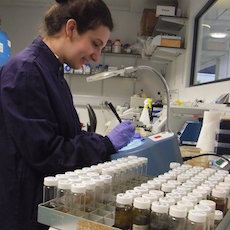Jessica Furner-Pardoe
We investigated a 10th-century remedy for eye infections (mBio 6:e01129-15). This eyesalve is highly bactericidal against a range of troublesome pathogens. It can kill meticillin-resistant Staphylococcus aureus in a mouse chronic wound model, and Pseudomonas aeruginosa in an ex vivo chronic lung infection model. Crucially, its efficacy depends on combining ingredients (garlic, onion, wine and bovine bile) exactly as specified by the text.
Preliminary data show that the eyesalve is less cytotoxic to human epithelial cells than over-the-counter chloramphenicol eyedrops, and does not trigger release of the proinflammatory cytokine interleukin-6 from these cells. Chemical fractionation revealed that antibacterial activity is present in only three fractions of the eyesalve, narrowing down the pool of potential active compounds
Objective
We will fully investigate the effects of the eyesalve and its active fractions on human epithelial cells and monocytes

